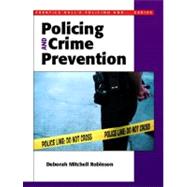
Deborah Mitchell Robinson is an Associate Professor of Criminal Justice at Valdosta State University in Valdosta, Georgia. She earned a B.S. degree in Public Relations from the University of Florida and M.S. and Ph.D. degrees in Criminology from Florida State University. She teaches in a variety of areas, including criminal law and procedure, victimology, criminological theory, and statistics, and has developed a Crime Prevention Through Environmental Design (OPTED) course at Valdosta State. She is a 1?O.S.T. certified instructor for the State of Georgia and an adjunct instructor for the Georgia Police Academy. She has presented numerous professional papers in the area of crime prevention and has published in the areas of crime prevention, victimology, and sexual deviance in the Encyclopedia of Criminology and Deviant Behavior, the Journal of Security Administration, and a chapter in Issues in Victimology Research. She is currently working to assess the impact of community-oriented policing strategies of several police agencies on police officers and the communities they serve in South Georgia as well as OPTED strategies in public housing communities.
| Acknowledgments | v | ||||
| Introduction | vii | ||||
|
|||||
| About the Authors | xiii | ||||
| SECTION I HISTORICAL ASPECTS OF POLICING AND CRIME PREVENTION | |||||
|
1 | (18) | |||
|
|||||
|
19 | (12) | |||
|
|||||
|
|||||
|
31 | (22) | |||
|
|||||
| SECTION II POLICING AND CRIME PREVENTION IN THE ACADEMIC SETTING | |||||
|
53 | (30) | |||
|
|||||
|
83 | (22) | |||
|
|||||
|
105 | (10) | |||
|
|||||
|
|||||
| SECTION III POLICING AND CRIME PREVENTION PROGRAMS AT WORK | |||||
|
115 | (12) | |||
|
|||||
|
127 | (10) | |||
|
|||||
|
137 | (28) | |||
|
|||||
| SECTION IV POLICING AND CRIME PREVENTION CAPSTONE | |||||
|
165 | ||||
|
|||||
|
The New copy of this book will include any supplemental materials advertised. Please check the title of the book to determine if it should include any access cards, study guides, lab manuals, CDs, etc.
The Used, Rental and eBook copies of this book are not guaranteed to include any supplemental materials. Typically, only the book itself is included. This is true even if the title states it includes any access cards, study guides, lab manuals, CDs, etc.